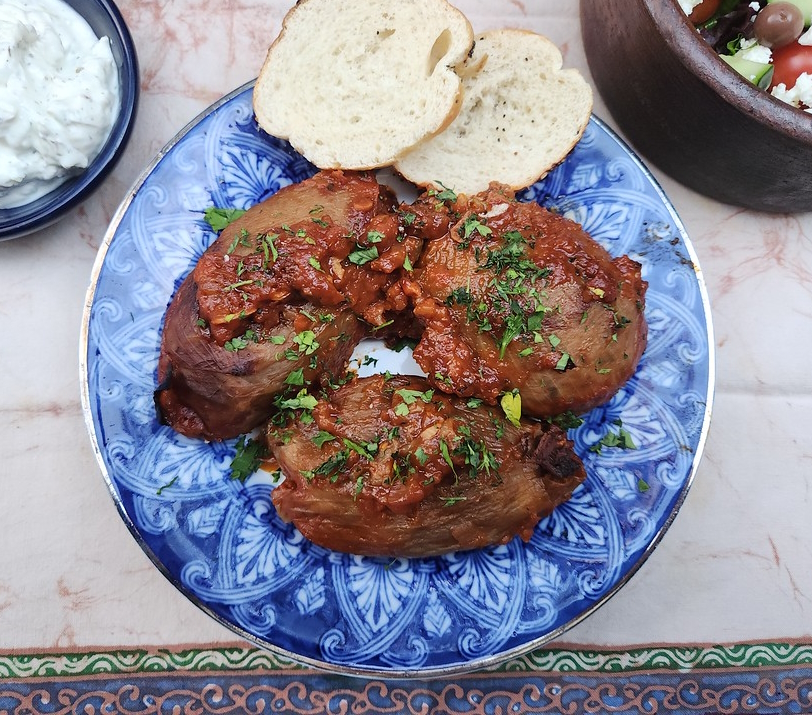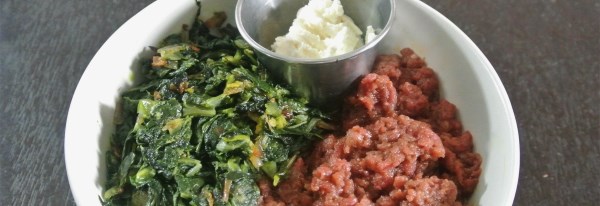
Kitfo differs for the standard fare found in most Ethiopian restaurants in America. A specialty of the Gurage people of Southern Ethiopia, this dish is now a popular throughout Ethiopia.
Ethiopian food within the U.S. typically showcases various types of stew (wat), sautéed dishes (tibbs) and the unique unleavened sourdough called injera. Kitfo, however, is distinct from these stalwarts of Ethiopian cuisine. It is neither stewed nor sautéed, served with specific side dishes, and normally not eaten with injera. The dish consists of lean minced meat flavored with aromatic spices and clarified butter, and typically is consumed raw. So how does it fit into our image of Ethiopian food?
Kitfo originates in the southwest of Ethiopia, a region known as the Southern Nation, Nationalities and Peoples' Region (SNNPR), from a cultural group known as the Gurage. The Gurage are an agricultural community that makes up only 2.5 percent of the total Ethiopian population, but still they have contributed to one of the most distinct and popular of Ethiopian dishes. The word Kitfo comes from the Ethio-Semitic root word meaning "to chop" or "to mince" and reflects the method of preparation for the dish. The dish shares flavors and ingredients with other Ethiopian food, but offers a distinctly Gurage way of eating.Kitfo Kitfo is a marvelous example of how food and ceremony become intertwined. For the Gurage, cattle are raised for butter and dairy production and therefore rarely eaten. Exceptions are made for celebrations or feasts, such as the Meskel, the festival of the True Cross, which is a religious festival for Ethiopian Orthodox Christians. Just like a classic Western tartare or crudo, the key to kitfo is using the highest quality raw meat.Kitfo he Gurage people's Kitfo is heavily spiced with mitmita (a blend of spices, salt and firey African bird eye peppers) and niter kibbeh, a spice infused clarified butter used in many Ethiopian dishes. At a Gurage table, the minced beef dish is always accompanied by gomen kitfo (Collard greens), ayib (a dry cottage cheese), and kocho (bread made from the ensente plant, known as a "false banana"). The inclusion of kocho is unique to the Gurage diet and is typically not found elsewhere in Ethiopia. The ensente plant is a staple crop that is integral to the Gurage life. The pulverized and fermented trunk and stalk are used to create kocho. Trying to obtain ensente (which is native to Ethiopia) in San Diego is next to impossible, so I recommend substituting injera.Kitfo Items such as mitmita, niter kibbeh and injera can be purchased at Awash Ethiopian Restaurant and Market and for responsibly raised, high quality beef I would recommend the Heart and Trotter Butcher Shop, which are across the street from each other.
Ingredients:
Niter Kibbeh:
- 8 tbsp unsalted butter
- ¼ tsp nigella seeds
- ¼ tsp fenugreek seeds
- ¼ tsp black cardamom, inner seeds
- ¼ tsp ajwain seeds
Gomen:
- 1.5 lbs collard greens (can substitute with kale or spinach), washed, stemmed and chopped very fine
- 4 tbsp Niter Kibbeh
- 1 medium yellow onion or 3 large shallots, minced
- 3 cloves garlic, minced
- 1.5” ginger, peeled and minced
- 2 red Thai bird eye chilies (can substitute with piri-piri peppers, mitmita or 3 fresh hot red chilies)
- White wine vinegar or lemon juice, to taste
- Salt and pepper, to taste
Kitfo:
- 1 lb lean beef (loin or top round)
- 2 tbsp (or to taste) Niter Kibbeh
- 1 tbsp mitmita
- 1 tsp ground coriander
Ayib:
- 4 cups whole milk
- 1/3 cup lemon juice
- salt, to taste
Preparation:
Niter Kibbeh:
- Melt the butter in a saucepan over low heat.
- Allow the butter to melt and clarify, uninterrupted. The butter will be ready once it is clear like ghee and completely liquefied.
- Coarsely grind the spices together in a mortar or a spice grinder and add to the clarified butter. Fry the spices, stirring to prevent burning, until fragrant, 1-2 minutes.
- Remove the saucepan from the heat and allow the mixture to rest and cool for 10 minutes before straining any residual solids.
Ayib:
- Add 4 cups of milk to a 2 quart saucepan and bring to a boil over medium high heat. Stay vigilant, as the milk has a tendency to over boil.
- Once the milk comes to a boil, reduce the heat and add the lemon juice, stirring constantly.
- Drop the heat to low, stir and simmer until the curd begins to separate from the whey.
- Once the curd separates, spoon the curd into a fine mesh sieve or strainer lined with cheesecloth. Gently run cold water over the cheese to remove residual lemon flavor.
- Place the sieve over a bowl, cover and refrigerate overnight, allowing any residual water to drain from the curd. The next day, place the cheese into a bowl and season with salt to taste.
Kitfo:
- Using a sharp knife, slice the beef thinly against the grain. Proceed to mince the meat by cutting the slices into thin strips (1/16th - 1/8th in) and then cutting the strips into cubes.
- Once the meat is minced, set aside.
- In a small pan, add niter kibbeh, mitmita and ground coriander. Heat the mixture over low until the butter is just warm and melted and the spices have infused.
- Once infused, remove the pan from the heat and add the meat.
- Stir to evenly coat the meat with the spiced butter. The traditional method is to mix the meat and butter by hand, although using a flexible spatula or a spoon works well. Traditionally the meat is served raw. (Note: For Kitfo leb leb, the partially cooked version, add the meat to the pan while on the heat. Cook until the meat is rare, 30 seconds.)
Gomen:
- Bring a pot of water to a boil and season with salt.
- Add the chopped greens to the water and simmer for roughly 15 minutes, until tender.
- Drain the collards and squeeze out any remaining water.
- On medium heat, melt the niter kibbeh in a small pot.
- Add the onion and sweat over medium-low heat until soft and golden brown, 10-15 minutes. (Note: Ideally the onions will be almost disintegrated. This will help to flavor the stew and contribute to the texture of the dish.)
- After the onions are golden and soft, add garlic, ginger and peppers.
- Saute ingredients until fragrant, about 3 minutes, taking care that nothing sticks to the pot.
- Add collards to the pot and saute, stirring to combine.
- Once collards are heated through and color has mellowed, remove from heat and stir in vinegar. Serve hot.
Eating:
This dish, like most Ethiopian food, is typically eaten with the hands. Using injera, scoop up a bit of kitfo mixed with gomen and some ayib. Alternatively, spooning one or all three items onto a piece of injera is easy and slightly less cumbersome for those not used to eating without western utensils.
Recipe and photo by: Liam Fox
- Details
- Hits: 2939
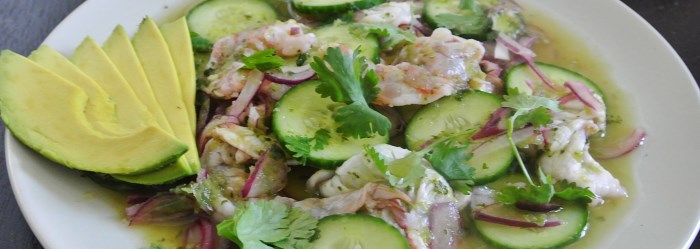
Aguachile, or more correctly Camarones en Aguachile, is a typical dish in the port town of Mazatlán, Sinaloa, Mexico. The dish has roots in the coastal community of Mazatlán and, like other forms of ceviche, is reliant on extremely fresh seafood and plenty of powerful seasoning. The basis for aguachile is found in its name: "Agua," water, and "chilies," chili peppers. Thus the basic ingredients of the marinade are hot peppers, water, lime juice and salt. Sliced cucumbers and julienned red onions are also necessary ingredients for a classic aguachile. The cucumbers serve as a cooling agent (since aguachile is supposed to be a fiery ceviche) and the onion can help balance the chili's sharp edge and the shrimp's natural brine.
Aguachile's birthplace, the northern state of Sinaloa, occupies a special place within the context of Mexico's history and economy, especially with regards to food production and cuisine. Sinaloa is known as the "breadbasket of Mexico" due to the scope and magnitude of its agricultural production. The state is one of Mexico's leaders in the production of staples such as rice, beans, wheat and vegetables, and the fishing and livestock industries are a thriving part of the economy. The geography of Sinaloa, with rivers running from the Sierra Madre Occidental range in the east to the Gulf of California in the west, contributes to the state's ability to produce a wide variety of goods. The diverse ecosystems of Sinaloa provide land than can support various types of agriculture, pastures and maritime industries. With this myriad of products available, it's no wonder that Sinaloa has produced some of the iconic dishes of northern Mexico, aguachile among them.
According to lore, before aguachile was made with shrimp, and before lime had a place in the marinade, the pulverized pepper-water mixture was used to rehydrate another (and equally magical) specialty of Sinaloa: machaca. The machaca of Sinaloa is a spiced and smoked dried beef jerky originally created to preserve precious protein. The pepper water was used to rehydrate the meat (and still impart flavor). When and why the transition from machaca to camarones (seafood) happened is anyone's guess, but presumably the introduction of lime juice occurred around the same time.
Another important element of aguachile is the type of pepper used. The most common peppers used in aguachile verde are, expectedly, jalapeño peppers and Serrano peppers, these varieties being extremely prevalent and easy to find. It is sometimes claimed that hotter peppers, like the chiltepe or pequin peppers, are more traditional, but as there are as many recipes as there are cooks, the possibilities are all but endless. Habañero, chile de arbol, chilie poblano, chilie guajillo and others have all appeared in recipes for aguachile. The considerations for the types of pepper used are the heat and the color. Using a dried chili will impart a smoky character and a red color, whereas using a young fresh chili will yield a bright vegetal, or fruity, quality and vibrant green color. Truly the consideration when selecting chilies is three fold: flavor profile, color and heat level.
Many modern examples of aguachile have expanded on the traditional blend of water, lime and chili by including flavoring components such as soy sauce or "seasoning" sauce (e.g. Maggi). The introduction of soy sauce as an ingredient in some aguachile represents the ever-growing pantry of cooks. Perhaps this is another stage in the development of this particular dish, not unlike the switch from machaca to camarones! On occasion, recipes have even completely done away with the "agua" of the dish, replacing it with more lime. Other variations include the addition of garlic, cilantro, oil, onion, hot sauce (typically a Mexican hot sauce) and other herbs such as mint and parsley.
Unlike the vast majority of ceviche, aguachile is not traditionally left in the marinade to cure. This particular dish, rather than cooking in the acidulated marinade, is classically eaten while the shrimp are still raw. This is, of course, not a hard and fast rule. Eating shrimp raw requires getting sushi grade, untreated product, which is nearly impossible to find. And the alternative, allowing the shrimp to "cook" in the lime juice, still yields a perfectly velvety texture and makes delicious snack.
Aguachile at first glance is a very simple dish, but that belies how difficult achieving balance can be. The few ingredients need to blend harmoniously to achieve the sublime balance of spicy, acidic, savory and sweet. It takes a steady hand and focus (not to mention a couple of attempts) to find a balance that works for you. In the end, it's all about the freshness of your ingredients and the balance between components that makes or breaks this dish. So put on some Pedro Infante (another great export from Mazatlan, Sinaloa), get some tostadas, avocados and maybe a michelada or two, and enjoy this classic of Mexico's western coast.
The recipe below is a variant on a classic Mazatlan style aguachile. I encourage you to play around with the amount of spice, lime and other ingredients in order to make this dish your own. For this recipe you will need a mortar and pestle (or molcajete), or a blender and a nonreactive bowl (preferably glass).
Ingredients:
- 1 pound large brown Shrimp, peeled and deveined
- 4-5 serrano peppers, minced
- 1 clove garlic, peeled
- ¼ cup cilantro, washed and chopped
- 2-3 tablespoons water
- 5-6 tablespoons lime juice
- ½ red onion, julienned
- 2 Persian cucumbers, halved and sliced, or 1 English cucumber, halved, seeded and sliced.
- Salt and pepper, to taste
- Avocado and tostadas, to serve
Preparation:
- Carefully split the shrimp in half lengthwise, discarding any residual veins in the process.
- Lay the shrimp halves onto a plate or baking sheet, ensuring there is no overlap.
- Salt the individual pieces of shrimp generously. This will cure the shrimp and begin the cooking process. Cover and place in the refrigerator for 1-2 hours.
- Using a large mortar and pestle (or a molcajete) pulverize the serranos into a paste, adding a bit of salt to act as an abrasive.
- Next, work in the clove of garlic, cilantro and two or three tablespoons of water until a smooth paste forms. Add the next ingredient only after the previous has been fully incorporated.
- Incorporate the lime juice, tasting for salt, acidity and heat, adjusting as necessary. The mixture should be loose and liquefied, with an aggressive heat and pronounced lime flavor.
- Remove the shrimp from the fridge and place into a large, nonreactive mixing bowl. Add the julienned red onions and the chili/lime marinade.
- Cover the bowl in plastic wrap and return for the fridge for 45 minutes to one hour.
- Allow the shrimp to "cook" in the marinade. The shrimp are ready when the flesh is completely white but tender and no signs of grey are present. The outer section of the shrimp (the sections formerly covered by shell) will be a light shade of pink.
- Peel the skin from the cucumber (if using an English or hot house variety) and cut in half. Remove the seeds using a small spoon, leaving the firm flesh intact. Then slice into ½ inch rounds and add to the shrimp.
- Season the mixture with salt and pepper to taste and serve with sliced avocado and tostadas.
*Note: Instead of using a mortar and pestle, add the chilies, garlic, cilantro, water and lime juice to a blender and blend until smooth. Season the mixture with salt and pepper once fully blended.
Michelada Ingredients:
- 2-3 dashes maggi
- 1 dashes soy sauce
- 5 dashes Tabasco (or other Mexican hot sauce)
- ¼ lime, juiced
- 1/8th teaspoon sugar
- 4 ounce Clamato
- Ice cubes (4 cubes)
- Mexican lager beer (i.e. Modelo, Bohemia, Pacifico, etc)
Michelada Preparation:
- Lightly cover a plate with Tajin, or similar spice mixture.
- Rim a pint glass with the juice of a lime wedge by running the wedge along the lip of the glass. Place the lip onto the Tajin-covered plate to coat the rim.
- Add soy sauce, maggi seasoning, Tabasco, sugar and lime juice to the bottom of a pint glass.
- Add clamato and stir.
- Top mixture with ice cubes and fill the glass with a light beer of your choice. I highly recommend Negra Modelo.
Recipe and photo by Liam Fox
- Details
- Hits: 3219
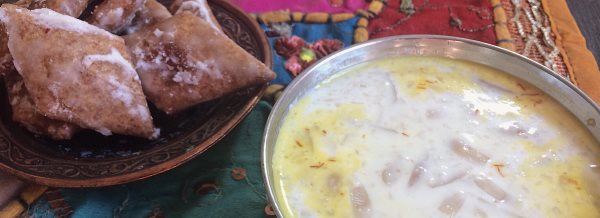
Indian Phirni and Skakkarpare are often enjoyed at the Indian Festival of Lights, Diwali.
This year October brings one of the most important festivals in the Hindu lunar calendar: Diwali. Diwali, or Deepavali, is a five day celebration for Hindus all over the world. The festival spiritually signifies the victory of hope, light, goodness and knowledge over their opposites—despair, darkness, evil and ignorance. Over the five festive days, families and communities across the Hindu world come together to celebrate the convivial holiday.
Interestingly though, Diwali isn't just a festival for Hindus. Jains, Sikhs and the Newar Buddhists of Nepal all celebrate Diwali as well, though with some variations. The religious tones of Diwali celebrations do vary from religion to religion, which we won't get into here, but the festive feeling runs through them all. Gift giving, gestures of peace, feasting, designing intricate rangoli (a South Asian decorative art), taking part in melas (a fair or community gathering) and shopping for new clothes are all integral to the Diwali experience.
In observing Diwali night, the third day of the festival, Hindus will often dress in their best attire, light diyas (lamps and candles) in and around their homes, give prayers (puja) to Lakshmi (the goddess of wealth and prosperity), watch fireworks and then feast. The feast is important in a Diwali celebration as it is a symbol of generosity and prosperity shared amongst family and friends. And while typically feasts will have savory dishes at their core, for many, Diwali is all about the sweet snacks known as mithai.
The term Mithai encompasses any and all sweet dishes from the Indian Subcontinent; this includes India, Pakistan, Nepal, Bangladesh and Sri Lanka. Thanks to this diversity within South Asia and the spread of South Asian peoples throughout the world, the variety of mithai for Diwali truly knows no bounds. Regionalism in Indian cuisine shows itself even among mithai, with the innumerable subcategories and variations on common recipes. Categories like burfi, kheer/payasam, kesari, ladoos, and halwa serve as the templates for regional and individual interpretation. Specific regional dishes, like gulab jamun, jalebi, and panjiri from the north or chomchom, sandesh and rasgulla from Bengal, illustrate the unique perspectives and originality of the cooks and cultures. The two dishes we will be focusing upon in this article are badam phirni and shakkarpare.
Badam phirni is a variation on the classic Indian sweet rice pudding known as kheer. Kheer, and all its variants, holds a special place at the festive table across South Asia. No matter one's religion, kheer is integral to any occasion, be it Diwali, Eid, weddings, birthdays or the like. Kheer has its roots in ancient Indian culinary tradition and has persisted throughout the centuries due to the availability of its main ingredients (rice and milk), and the ease of preparation. Badam phirni utilizes ground rice (thus making it a phirni) and almond meal as thickening agents. This style of kheer is thought to have originated in Persia, illustrating the historical culinary link between Northern India and Central Asia.
The second featured recipe, shakkarpare, is a snack popular in Northern and Western India, in particular in Gujarat and Maharashtra. Shakkarpare is a versatile fried snack that, depending on the intent, can be savory, spicy or sweet. The simple dough is formed into diamonds and then fried in ghee until perfectly crisp. Two variants include Maharashtrian (where sugar is included in the dough) and Rajasthani (where a sugar syrup coats the cookies). The following recipe outlines the Rajasthani version.
Badam Phrini Ingedients:
- ¼ cup basmati rice (ground)
- 1 quart milk
- ¾ cup sugar
- 18 almonds, blanched and sliced
- 6 green cardamoms shelled and ground, or 1 teaspoon ground cardamom
- 10 strands saffron
- 1/8 teaspoon rose water (optional)
Preparation:
For the ground rice:
- Rinse the basmati rice three times in water, until rinsing water is no longer cloudy and excess starch is removed. Then drain and place onto a cookie sheet or plate to dry.
- Once dry, grind the rice in a coffee grinder or a mortar and pestle until the texture resembles fine semolina flour.
For the Phrini:
- Heat the milk in a 2 quart sauce pan until warm. Once warm remove one tablespoon of milk and set aside.
- Add saffron strands to the reserved tablespoon of milk and allow the saffron to bloom.
- Bring the milk in the pan to a boil. Once boiling, stir in the sugar and ground rice. Lower the flame to medium-low and cook the rice, stirring occasionally to prevent lumps.
- With a mortar and pestle, grind half of the almonds into a paste, adding some of the milk to create a smooth paste.
- Once the rice is nearly done, stir in the sliced almonds, cardamom powder and saffron infused milk. Reserve some of the almonds for garnish.
- Continue cooking for 5-6 minutes, or until the mixture is thickened to a custard-like consistency. The total cooking time should be somewhere around 25 minutes after the rice was added. At this point, remove from the flame and add rose water, if using.
- Portion the phrini into serving bowls. Allow the phrini to cool and refrigerate until chilled and ready to serve.
- Serve garnished with saffron threads and some reserved sliced almonds.
Shakkarpare Ingredients:
Dough:
- 2 cups flour, mixed whole wheat and all-purpose (3-1 ratio)
- 2-3 tablespoons ghee, room temperature
- ½ cup (as needed) water
- 1 teaspoon ground fennel seeds (optional)
Sugar syrup:
- 1 cup sugar
- ½ cup water
- 3-4 saffron threads (optional)
- Oil or ghee for deep frying
Preparation:
Shakkarpare:
- Place the flour mixture in a non-reactive mixing bowl. Add the room temperature ghee and mix into the flour using your fingertips. The mixture should be well incorporated.
- Next add water gradually, mixing until a semi-soft dough is formed. Depending on the flour used, the ratio of flour to water will be different. Regardless, the dough should not be sticky.
- Divide the dough into three equal sized balls and roll them into circles, 7-8 inches in diameter.
- Using a sharp paring knife cut the dough perpendicularly in order to form small diamond or square shapes.
- Heat frying oil in a large pot or wok, over medium heat, to around 350-375 degrees Fahrenheit. Ensure that the oil level is not very high. The frying does not require very much oil due to the size of the shakkarpare.
- Test the temperature of the oil by adding a small piece of scrap dough. The dough should float to the surface fairly quickly. If it sits on the bottom of the pot, the oil is not hot enough.
- Carefully add the raw shakkerpare to the hot oil. Do not overcrowd the pot, as this will diminish the quality of the fry. Each piece should have a small amount of room to move.
- When the shakkarpare begin to turn golden brown, flip the pieces using a slotted spoon or spatula. Continue frying and flipping until the individual pieces are a deep golden brown.
- Once desired color has been achieved removed the shakkarpare from the oil and allow to drain on a paper towel. Repeat the process until all the dough has been fried.
Glaze
- Add the sugar and water to a pan and heat over a low flame until the sugar dissolves.
- Continue cooking until the mixture becomes sticky. At this point, add the saffron if using. Simmer until the sugar syrup has reached a 2-3 thread consistency. It should take roughly 10-15 minutes on medium heat. See the note for how to check this.
NOTE: To check the syrup for proper consistency, take some of the hot syrup from the pot using a spoon and allow it to cool slightly. Take a small portion of the cooled syrup between your index finger and thumb, press and a separate your fingers. As they pull apart, two or three "threads" of syrup should connect the fingers.
Recipe and Photo by Liam Fox
- Details
- Hits: 2669
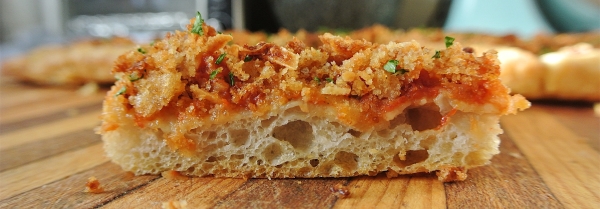
Sicillian Sfincione is a dish that many Palermitani (people of Palermo) hold dear. The city of Palermo has ancient roots, dating back to the Phoenician establishment over 2700 years ago. Long before "Sicily" or "Italy" even existed, the port city was known as Ziz (which means "flower") by its initial settlers and by the Punic-speaking peoples in Carthage. Over the ensuing millennia the city's streets saw the feet of Greeks, Romans, Byzantines, Arabs, Normans, Aragonese, Swabians and eventually Italians. All these peoples brought with them their unique perspectives, cultures and ideas, and all left their mark on Palermo. As a result the city, like all of Sicily, reflects these influences through the most delicious of mediums: food.
In Palermo, street food plays a significant role in daily life. Bread in particular is king in the streets of Palermo, with dishes such as Pani ca Meusa (bread rolls with sliced pork spleen), panelle (chickpea batter fritters served on a roll) and the focus of this article: sfincione.
Sfincione is thought of as the precursor to New York City's very own "Sicilian Pizza." The structure of both dishes is rather similar: flatbread baked in a rectangular pan, topped with a sauce (usually tomato based) and garnished with cheese—though the devil is in the details. The Sicilian slice one might find in any pizzeria across America (especially one owned by Sicilian Americans) features a sauce akin to marinara, mozzarella made from American cows and typically features some type of cured meat. All this lends itself to the concept of pizza as we know it, though mozzarella and marinara have nothing to do with sfincione. The Palermo specialty sfincione relies on a thick, robust sauce of caramelized onions, dried chili, oregano, anchovies and tomatoes and it is garnished with caciocavallo and breadcrumbs, rather than mozzarella and pepperoni.
The difference between caciocavllo (literally "horse cheese") and mozzarella is stark to say the least. The former is the name for a family of hard, stretch-curd cheeses native to Sicily and greater Southern Italy. Typically the flavor is sharp and has a mild nuttiness, though this depends largely on the origin of the milk used. Caciocavallo can be made from sheep's milk or cow's milk, but despite its name the one milk that it is never made from is horse milk. The name caciocavallo is thought to come from the drying method, in which two cheese forms are places "a cavallo," or straddling a stick like one would a horse. In Sicily, the cheese is predominantly made from cows milk (as in the Caciocavallo Palermitano). Mozzarella, by comparison, is the mild and silky cheese traditionally made from Italian buffalo milk. In the USA, cow's milk mozzarella came to prominence due to the extensive dairy farming that took place in the 19th century, the same time that many Italian immigrants settled along the Eastern Seaboard. The influence of these immigrants led to the production of a myriad Italian style cheeses from northern and southern Italy, like mozzarella (Southern) and provolone (Northern).
The cheese is, however, a compliment. It is the touch that gilds the humble dish of bread and sauce. And while many would (myself among them) contend it is an absolute necessity, sfincione's power truly lies in the communion of well-made bread and fiery sauce. The sauce brings together onions, garlic, oregano, tomatoes, anchovies and chilies into something greater than the sum of it's parts. All of these common ingredients give insight into the palate of the Palermitani, with heat, deep caramelized sweetness, rich umami and subtle acidity, which meld into a rich mélange atop crisp yet pillowy bread. The Sicilian palate reflects, like so many palates, the best use of what is available. The anchovies are a common sight throughout the Mediterranean sphere because they are both abundant and relatively inexpensive. Tomatoes are highly prized in Sicily, with those grown around Ragusa and Syracuse reaching protected trade status in the European Union. Onions, herbs, garlic and olive oil all function as a basis for many dishes in Sicilian cooking, so it's no surprise to see them featured heavily in this dish.
Sfincione gives an interesting insight into the simple, hearty and delicious food that has come to define Sicilian and Italian food as a whole. The dish is defined by its rustic and affordable character and showcases key elements of the Mediterranean diet. Without this humble dish the American pizza culture would not be what it is today, and this connection shows how cuisine can grow and adapt on new shores and to new palates.
Ingredients:
Dough:
- 4 cups of all purpose flour (or bread flour)
- 2 teaspoons kosher salt
- 1 teaspoons commercial baking yeast
- 2 tablespoons olive oil (ideally Sicilian olive oil)
- 1 1/2 cups water
Sauce:
- 1/4 cup olive oil
- 3 medium yellow onions, halved and sliced against the grain
- 1 28-ounce can San Marzano tomatoes, crushed by hand
- 3 cloves garlic, minced
- 8 anchovy fillets, finely chopped
- 1 teaspoon dried oregano
- 1 teaspoon dried marjoram
- 1 tablespoon red pepper flakes
- Kosher salt (to taste)
Bread crumbs:
- 1/2 loaf rustic bread (like Levain), cut into 1/2 in. thick slices, or 1/2 loaf of day old rustic bread, broken up into small bite sized pieces
- 1/4 cup olive oil
- 3 ounces Paciocavallo, or Pecorino Romano, or a combination of the two, grated
To Finish:
- 5 ounces Caciocavallo, or Pecorino Romano, or a combination of the two, grated
Preparation:
For the Dough:
- Combine flour, salt and yeast in a large, nonreactive bowl and whisk to combine.
- Add olive oil and water to the dry ingredients and combine (by hand or with a spoon) until no dry flour remains. The dough should be quite wet, and whatever you do, do not add more flour.
- Cover the bowl tightly with plastic wrap and refrigerate for 12 hours to 3 days.
NOTE: Try and make the measurements for the dough exact. The moisture content is key in this recipe. Also best results come from longer fermentation times, so my recommendation is to allow the dough to ferment for three days.
For the Breadcrumbs:
If using day old bread skip to step 3.
- Preheat the oven to 300 degrees Fahrenheit and ensure one of the racks is placed in the center of the oven.
- Place the slices of bread on a rimmed baking sheet and bake for 25-30 minutes, or until dried and hard.
- Break up the slices and place into food processor with olive oil and caciocavallo.
- Pulse the ingredients until the bread is broken up into small crumbs and cheese and oil have bound to the bread.
For the Sauce:
- Heat the olive oil in a wide sauté pan, or skillet, over medium heat until shimmering.
- Add the onions and cook, stirring frequently, until the onions begin to soften and brown.
- Once onions are a deep golden brown, add garlic, anchovies, oregano, marjoram and chili flakes and cook until fragrant, approximately 30 seconds. Add the tomatoes to the mixture, stir to combine and bring to a simmer.
- Once simmering, reduce heat to the lowest possible setting and cook for 30 minutes, stirring occasionally. The mixture should be deep red and thickened.
- Season with salt and remove from the heat. The sauce will keep in the refrigerator for a week.
Assembly:
- Pour 1/8 of a cup of olive oil directly onto a rimmed baking sheet (half sheet pan). Carefully remove the dough from the bowl and place onto the baking sheet. Gently form it into a ball, do not overwork the dough, and pour the remaining 1/8 cup of oil over the dough.
- Let the dough rise for 2 hours at room temperature (in a cool oven is a good place to do this). In this time period the dough will relax and spread out in the pan.
- After two hours have passed, gently stretch the dough to fit the entire pan and allow to rest for an additional 30 minutes.
- After dough has rested, heat the oven to 450 degrees Fahrenheit and place a baking stone on the bottom of the oven. If you don't have a baking stone, place a rack onto the lowest possible level.
- Spread a layer of sauce onto the dough, stopping 1/4 inch away from the edge. Note that the sauce spreads best at room temperature, and take care not to put too much sauce as it can deflate the dough.
- Add a generous layer of grated cheese onto the sauce. Finish the entire surface of the dough with the breadcrumbs and drizzle oil over the top.
- Place the pan directly onto the baking stone (or the oven rack) and bake until the top layer is golden brown and the bottom is crisp and bubbly, about 25-30 minutes.
- Remove the finished Sfincione from the pan using a metal spatula and transfer to a large cutting board. Cut into even sized squares and serve immediately.
Recipe and photo by Liam Fox
- Details
- Hits: 4457
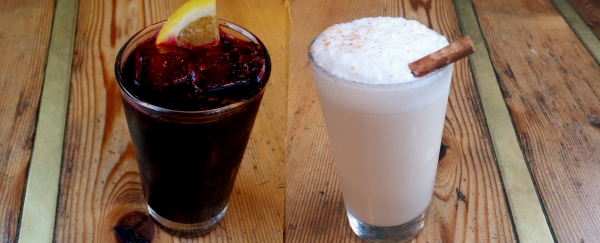
While eggnog and various kinds of hot mulled wines are popular Christmas drinks here and in Europe, this month you can learn how to make Jamaican Sorrel Punch and Puerto Rican Coquito Fizz! Although they hail from southern latitudes, both of these drinks will warm you on the chilly nights here in San Diego.
The Christmas celebration, in all its forms, unites families and Christians around the world. In San Diego, the Christmas brings decorations, sales, holiday spiced beers, tamales and the images of Santa Claus. Around the world there are similar and seasonal events that take place, be they caroling, decorations, holiday foods or, as is this month's focus, special drinks.
The history of celebratory holiday drinking is long, with Christian examples dating back into the Middle Ages in Europe, and may well have something to do with the feasting that accompanies these holidays. The punches, mulled wines, and nogs that pop up in grocery stores each winter showcase the variety of adult and virgin beverages that signal the season today.
The versatile beverage known as punch was introduced back in the 17th century. The word itself is a loan word from Sanskrit meaning five, a reference to the classic number of ingredients. Originally tea, lemon, sugar, alcohol and spices made up a classic punch and it is still a good base to jump from. Modern examples of punch are typically a little more involved, and reflect the diverse palates that build them.
Sorrel punch (a Jamaican holiday staple) is an excellent example of this. The base is a tea made of hibiscus flowers (known in Jamaica as sorrel, not to be confused with the bitter herb) and spices like clove and allspice, both of which are absolute necessities in Jamaican cuisine. Fortified with sugar, fiery Jamaican white rum and citrus, sorrel punch is for many of Jamaican origin an absolute necessity during the holidays. Though the bright and citrusy beverage may not read as "holiday" given the idea of a snowy cold holiday season, its flavor and nature compliment the Caribbean climate. A tropical climate with steady average temperatures, it's not uncommon to experience temperatures in the 80's around Christmas, so it stands to reason that the Jamaican palate would stray away from heavy or warm beverages, favoring the cooling relief that hibiscus tea provides.
Similar examples are found in Mexico and Guatemala where ponche heralds the Christmas season. Ponche de Navidad and Ponche de Frutas are for many Central Americans and Mexicans necessities during Las Posadas, the nine days leading up to Christmas Eve. The mixture of fruit, sugar, water, spices and alcohol varies based on preference and location. Mexican ponche typically utilizes fruits like tejocotes (a member of the hawthorn family that resembles a crab apple), guava, tamarind and pear, while the Guatemalan version often leaves out the tejocote and adds papaya, pineapple and apricots. Dried fruit, cloves and cinnamon all add depth to the mixture. Though typically served warm, some choose to serve this beverage lightly chilled during warmer winters.
In contrast to the light and fruity punches of the tropics, creamy beverages like eggnog prevail in colder climates, notably the United States. The beverage has its origins in Britain via the hot milk beverage posset. A nod to the predecessor of today's eggnog are warmed versions like the Tom and Jerry, an American egg-based and brandy spiced hot beverage. Modern eggnog typically provides a rich, cooling and savory experience that typifies holiday drinking in the US. Other beverages, both egg based and egg-less, hold the same esteem around the world. In Puerto Rico a beverage called coquito is a Christmas time indulgence. The mixture of rum, coconut milk, condensed milk and spices provides sweet, cooling relief from the tropical climate, while those warm winter spices pair perfectly with rum. Though referred to as "Puerto Rican Eggnog," this term is a bit of a misnomer. In conquito eggs are an option, not a necessity.
Unlike eggnogs and other creamy rich drinks, mulled beverages' richness rely on the combination of wine and spices. Warm drinks like glögg, glühwein and wassail are staples of many European Christmas celebrations. The practice of mulling wine spread throughout Europe by the Romans during their expansion into empire around two millennia ago. In the ensuing centuries the various peoples of Europe have added their own particular flairs to the practice. In German speaking countries, glühwein is an a popular winter warmer. Spiced with clove, cinnamon, cardamom, citrus and anise, the beverage is a low alcohol guard against the typically cold Northern European climate. Glögg functions in much the same way in Sweden. Known as gløgg in Norway and Denmark and glögi in Estonia and Finland, the mulled wine is popular all across Scandinavia. The various recipes for the mulled wine share the penchant for baking spices, raisins, almonds and citrus peel to round out the warmed mixture of wine, vermouth, akavitt and sometimes port. In most cases the various forms of glögg are accompanied by sweet treats like gingerbread, rice pudding and Danish pancakes, indicating the relationship between sweet and savory at Scandinavian tables. A similar beverage is wassail, a mulled cider that many English consume around Christmas and the celebration known as Twelfth Night. The drink began as a mulled wine, though the base spirit became hard cider, favoring a domestic product over an imported one. The accompanying ceremony, known as "wassailing," lives on in the Southwest of England and is inextricably linked to cider production. The drink has taken hold throughout the rest of England as the beverage of choice for the holiday season.
Sorrel Punch (Jamaica)- Ingredients
- 6 ounces hibiscus flowers
- 5 ounces ginger, chopped
- 4 Cloves
- 1 Cinnamon stick
- 6 Allspice berries
- 1 cup of Jamaican white rum (Wray and Nephew suggested)
- 1 cup simple syrup
- 8 cups water
- 5 ounces orange juice
- 1 ounce lime juice
Sorrel Punch Preparation
- Bring the water to a boil in a large pot.
- Once boiling add the hibiscus, ginger, cloves, allspice and cinnamon and remove from the heat.
- Allow to cool and refrigerate overnight.
- The next day, strain the contents of the pot through a fine mesh strainer lined with cheesecloth.
- Add the rum, simple syrup, orange juice and lime juice to the strained liquid.
- Stir well and serve over ice.
Coquito Fizz (PR) - Ingredients
- 12 ounce can evaporated milk
- 15 ounces coconut cream
- 14 ounces can Sweetened Condensed Milk
- ¼ teaspoon ground cinnamon
- ¼ teaspoon ground clove
- 1/8 teaspoon ground nutmeg
- 1 teaspoon vanilla extract
- Puerto Rican white rum
- 1 egg white
Coquito Fizz
- In a blender, combine all the ingredients except the rum and the egg white.
- Blend until all the ingredients are combined.
- If making a large batch, add six ounces of rum to the mixture, transfer to a pitcher and chill for at least an hour before serving.
- If making a fizz, add two ounces of the coquito mix to a Boston shaker.
- Add one and a half ounces of rum to the shaker.
- Add the egg white to the shaker and shake to emulsify.
- Add ice to the shaker and shake once more, for about 20 seconds.
- Strain the mixture into an 8oz highball glass without ice.
- Top with carbonated water (I prefer Topo Chico brand mineral water) and garnish with grated cinnamon.
Recipes and photos: Liam Fox
- Details
- Hits: 3445
Page 2 of 5








